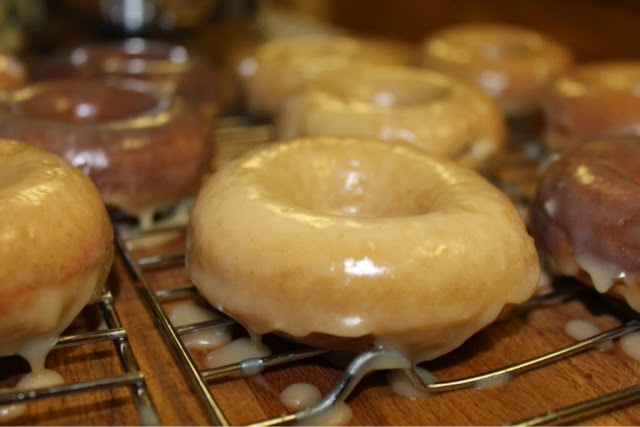Monkey bread is one of those breakfast foods that really screams 'dessert'...but everyone looks the other way when it's placed on the breakfast table because it's too good to pass up.
In case you don't know what monkey bread is, I'll just say now that it has nothing to do with monkeys: it is basically composed of balls of sweet dough dipped in butter, rolled in cinnamon-sugar, and baked in a bundt pan after being drenched in more butter and sugar.
This is why we only eat it once a year...
...only on that day that is so special and anything flies, including dessert for breakfast, do we eat monkey bread. Christmas Eve we roll the dough balls, and Christmas morning it is a simple thing to pour the butter and brown sugar glaze on and pop it in the oven while everyone gathers around the Christmas tree.
I don't remember when we first started having monkey bread every Christmas, but it's a Christmas tradition that I love now. When we were little, we used to jump on helping make the monkey bread. I loved popping open the cans of biscuits, extracting the squishy dough, and forming it into little round balls for someone to roll in the cinnamon-sugar. Then in the oven, the magic happened: the balls of dough poofed up and the cinnamon sugar (or so I thought—it was actually the brown sugar-butter mixture) became a caramely, sugary crust. I could barely wait until it cooled enough to eat, and as soon as possible I would tear off the pieces with the most caramelized sugar and pop them in my mouth. Years later, I still love making monkey bread—and now I have found the perfect recipe.
For the past several years we have lived in foreign countries, so we haven't been able to use the usual canned biscuits to make it a super simple meal. Instead, we used a sweet dough recipe—but I felt that the recipe could be even better. So this year, I jumped in before anyone could even blink, and suggested trying this recipe from Sally's Baking Addiction. Based on previous experience with her recipes, I knew that the monkey bread would come out good, but I didn't know just how incredibly finger-licking good it would turn out to be! (And finger-lick you must because monkey bread is too good to waste a bit—plus you don't want sticky gifts, do you?)
No matter how many pieces of monkey bread I eat (that's code for A LOT), there always seems to be enough for everyone and we end up with extras.
See? Plenty for my breakfast on boxing day (that's December 26 to you Americans).
Tearing pieces off, my family thought it was a little under-baked at 30 minutes—on the other hand, I just sank into my chair with a happy smile on my face; I thought that it was perfectly soft and delicious, melting in my mouth, mesmerizing me into taking more and more.
We skipped the glaze on our monkey bread because it was plenty rich and sugary without it! However, if used, the glaze would definitely make the monkey bread taste like (my idea of) the perfect cinnamon roll.
This monkey bread is a real treat—warm, sticky, and delicious, melting in your mouth in a perfect blend of cinnamon and sugar.
Monkey Bread
Serves: 6-7 people
Notes:
This recipe can be made using biscuits (I have not tested this, but it should work–please comment on this post about your experiences if you try this method with this recipe).
Replace the dough with 3 cans of buttermilk biscuits (non-flaky). Skip all rising of the dough. Open cans of biscuits and cut each round into quarters. Dip in butter (optional), coat in cinnamon-sugar, pour on topping, and bake; make and pour on vanilla glaze (optional).
The Pioneer Woman has a great recipe using biscuits.
Recipe adapted from: http://sallysbakingaddiction.com/2014/06/30/homemade-monkey-bread-aka-cinnamon-roll-bites/






























